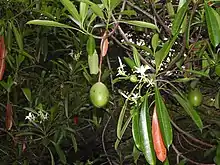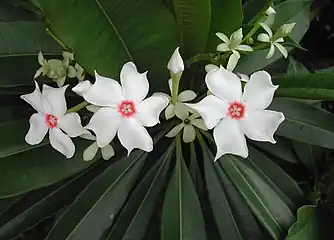| Cerbera manghas | |
|---|---|
 | |
| Scientific classification | |
| Kingdom: | Plantae |
| Clade: | Tracheophytes |
| Clade: | Angiosperms |
| Clade: | Eudicots |
| Clade: | Asterids |
| Order: | Gentianales |
| Family: | Apocynaceae |
| Genus: | Cerbera |
| Species: | C. manghas |
| Binomial name | |
| Cerbera manghas | |
| Synonyms | |
|
Synonyms list
| |
Cerbera manghas,[1] the sea mango, is a small evergreen coastal tree growing up to 12 metres (39 ft) tall. It is native to coastal areas in Africa, Asia, Australasia, and the Pacific islands. It is classified as one of the three species in the genus Cerbera that constitute mangroves.
Description
The shiny dark-green leaves grow in a spiral arrangement, and are ovoid in shape. The flowers are fragrant, possessing a white tubular five-lobed corolla about 3–5 cm (1.2–2.0 in) in diameter, with a pink to red throat. They have five stamens and the ovary is positioned above the other flower parts. The fruits are egg-shaped, 5–10 cm (2.0–3.9 in) long. At maturity they turn bright red.
Toxicity
The leaves and the fruits contain the potent cardiac glycoside cerberin, which is extremely poisonous if ingested. This was utilised in trials by ordeal done towards criminal suspects in the Merina Kingdom ruling the island of Madagascar[2][3] until the practice was abolished during Radama II's reign. On the opposite spectrum, Fijians use its (vasa, rewa) leaves in dried form to treat skin irritations and eye pains.[4]
Long ago, people used the sap of the tree as a poison for animal hunting.[5]
Goffin's cockatoo is one of the creatures known to eat sea mangos.[6] In addition, the Coconut crab can become toxic to humans if it eats too much sea mango due to a buildup of cardiac cardenolides.
Gallery


 Flower
Flower
 Unripe fruit
Unripe fruit
References
- ↑ POWO: Cerbera manghas L.
- ↑ "33. Le Tanghin (Cerbera)". Catalogue des fruits et des plantes modelés (in French). Paris: Carporama. 1829. pp. 25–26.
- ↑ Boiteau, Pierre (1999). "tangena". Dictionnaire des noms malgaches de végétaux (in French). Vol. III. Editions Alzieu – via Malagasy Dictionary and Malagasy Encyclopedia.
- ↑ Keppel, Gunnar; Ghazanfar, Shahina A. (2011). Trees of Fiji: A Guide to 100 Rainforest Trees (third, revised ed.). Secretariat of the Pacific Community & Deutsche Gesellschaft für Technische Zusammenarbeit. pp. 44–5.
- ↑ "Cerbera manghas L." Flora Fauna Web. Retrieved October 4, 2017.
- ↑ Yirka, Bob (September 3, 2021). "Wild cockatoos observed making and using tools to eat sea mango pits". phys.org.
 Media related to Cerbera manghas at Wikimedia Commons
Media related to Cerbera manghas at Wikimedia Commons